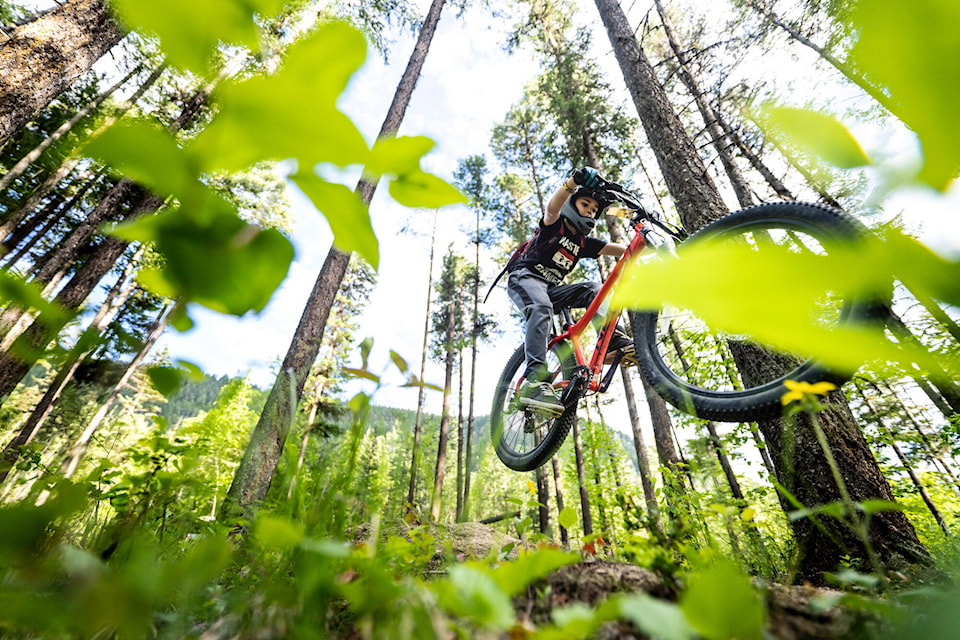By Sam Laskaris, Local Journalism Initiative Reporter, Windspeaker.com
Patrick Lucas can now add filmmaker to his resume.
Lucas wrote and helped produce Dirt Relations: The Story of the Indigenous Youth Mountain Bike Program.
The 37-minute documentary about the program he founded 11 years ago will have its world premiere on Feb. 23 during the opening night of the Vancouver International Mountain Film Festival. The film will be screened at the Centennial Theatre in North Vancouver.
Lucas, who lives in Courtenay, B.C., is a former community planner who worked with various First Nations throughout the province.
Since launching the Indigenous Youth Mountain Bike Program, he has helped build mountain bike trails for about 40 First Nations in B.C.
The program was featured in an episode of the series Return To Earth on Outside TV two years ago.
���߲��о����That was a great experience and it actually led to this (film) because it���߲��о����s only on Outside TV,���߲��о���� Lucas said, who is looking to expand the work of the mountain bike program.
While the episode on Outside TV kind of caught the idea of the program, it didn���߲��о����t quite get it all.
���߲��о����So we wanted to do it again. That���߲��о����s what led to this project,���߲��о���� he said.
Dirt Relations is not, however, simply a film. Lucas is hoping it will raise awareness.
���߲��о����That���߲��о����s part of our goal,���߲��о���� he said. ���߲��о����We want to keep growing the organization. We want to keep getting more kids out on bikes and more trails built in First Nations communities and kind of keep that discussion around reconciliation and recreation going.���߲��о����
Lucas, who is not Indigenous, said improving relationships between Indigenous and non-Indigenous people has become a huge part of the mountain bike program.
���߲��о����Our primary goal with this is that conversation, sharing stories and getting people to talk about what does it really mean to engage in reconciliation,���߲��о���� he said.
���߲��о����People throw that word around, and `decolonize���߲��о����, like it���߲��о����s a perfume or a cologne. But through our experiences, we���߲��о����ve learned really practical things, like reconciliation should be kind of centred on very practical day-to-day issues.
���߲��о����It���߲��о����s not all theory or academics. We���߲��о����re talking about building trails in a way that upholds Indigenous rights and title, that doesn���߲��о����t uphold the colonial structure that has built around recreation, and about getting kids reconnecting to their lands and territories. It���߲��о����s basic stuff. I think that���߲��о����s where we need to return the conversation to because it���߲��о����s been kind of hijacked in a lot of ways. And nobody really knows what reconciliation means.���߲��о����
Thomas Schoen, the program���߲��о����s director of trails and parks development, believes trail building, involving Indigenous people from communities and non-Indigenous program reps, is an amazing tool when it comes to reconciliation.
���߲��о����We���߲��о����re working side by side, in the dirt, we���߲��о����re talking about the past, we���߲��о����re talking about the pain, about the hurt,���߲��о���� he said. ���߲��о����There���߲��о����s no way to form a better bond than by working shoulder-to-shoulder to create something for the people.���߲��о����
Dirt Relations also focuses on Tom Eustache, a Simpcw First Nation member, who is a director with the Indigenous Youth Mountain Bike Program.
���߲��о����Patrick and Thomas gained my trust because they actually came out and built trails,���߲��о���� Eustache said. ���߲��о����They were some of the few people who came to the community and followed through on what they said they were going to do.���߲��о����
Lucas said the Vancouver festival is just the start of where the film will be shown. It has been submitted to various festivals around the world.
���߲��о����And we���߲��о����re already getting a lot of requests for screenings,���߲��о���� he said. ���߲��о����I think it���߲��о����s going to be really good.���߲��о����
Lucas said he���߲��о����s emailed every mountain bike club in British Columbia. He���߲��о����s also contacted other clubs throughout Canada and the United States.
���߲��о����Hopefully, we���߲��о����ll set up as many screenings as we can,���߲��о���� Lucas said. ���߲��о����We might do a little bit of fundraising out of it. But mostly it���߲��о����s just we just want the film to be seen by as many people as humanly possible.���߲��о����
Lucas is also hoping to expand the mountain bike program to other provinces and into the United States as well.
The program had its first out-of-province initiative last year when it worked with reps from the Namayagoosisagagun First Nation in northwestern Ontario. Plans were laid out and work was started on a trail in the community.
���߲��о����There���߲��о����s always been groups that have contacted us and they want to work with us,���߲��о���� Lucas said. ���߲��о����The struggle is that we don���߲��о����t know the funding programs in other places. Like, I know the funding here (in B.C.). I can get money here. It���߲��о����s never been a huge issue. But once you get into, say Ontario, everything changes.
���߲��о����Not only the funding changes but those are treaty First Nations, so the relationship with land base is dramatically different. But I���߲��о����d love to do way more. And I hope this (film) will get more people calling us.���߲��о����
READ ALSO:



